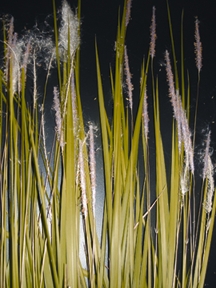Sungrass

Sungrass (chhan) tufted perennial light loving grass, Imperata cylindrica, of the family Peaceae (=Gramineae), grows in open areas, with underground succulent rhizome. Leaves are variable, very short to 1.5 m long, erect, linear to linear lanceolate; distributed throughout the tropical and temperate regions of the Old World and in parts of temperate South America. Two habitat forms, viz depauperate form and savannah form occur in low-lying swampy grounds, water logged areas to denuded dry hills in Bangladesh. The depauperate form with minute filiform culms 7.5-10 cm high with small leaves occurs in lawns and areas subject to continual cutting or grazing. The savannah form is strongly gregarious with stout culms of up to 1.5 m high, and broad leaves. Its leaves make a good and durable thatch; also used for making ropes, mats and cowry bags, baskets, etc.
Sungrass is a good soil binder; pigs eat rhizomes; young leaves are good forage. A decoction of rootstock is given in diarrhoea, dysentery and gonorrhoea. In Bangladesh it is an important non timber forest product and in some areas it is also a cash crop. Generally it grows in bare hills. It is estimated that about 2.15 million bundles of sun grass is produced every year worth of US $ 0.5 million; this provides an employment opportunity for about 60,000 people. The grass spreads rapidly by seeds and by root-stocks. Wind disperses the light seeds to new situations. Once established, the grass multiplies rapidly by rootstocks.
One-year-old leaves are harvested during winter months for thatching. For thatch production the grass fields are prepared by burning after harvest. Fire makes the ground clear that helps in easy emergence of shoots with the onset of monsoon. Once a land is invaded by grass it is very difficult to raise other plants. Planting quick growing cover or shade shrub or trees help in eradicating the weed; prolonged shade kills the grass. [M Khairul Alam]
